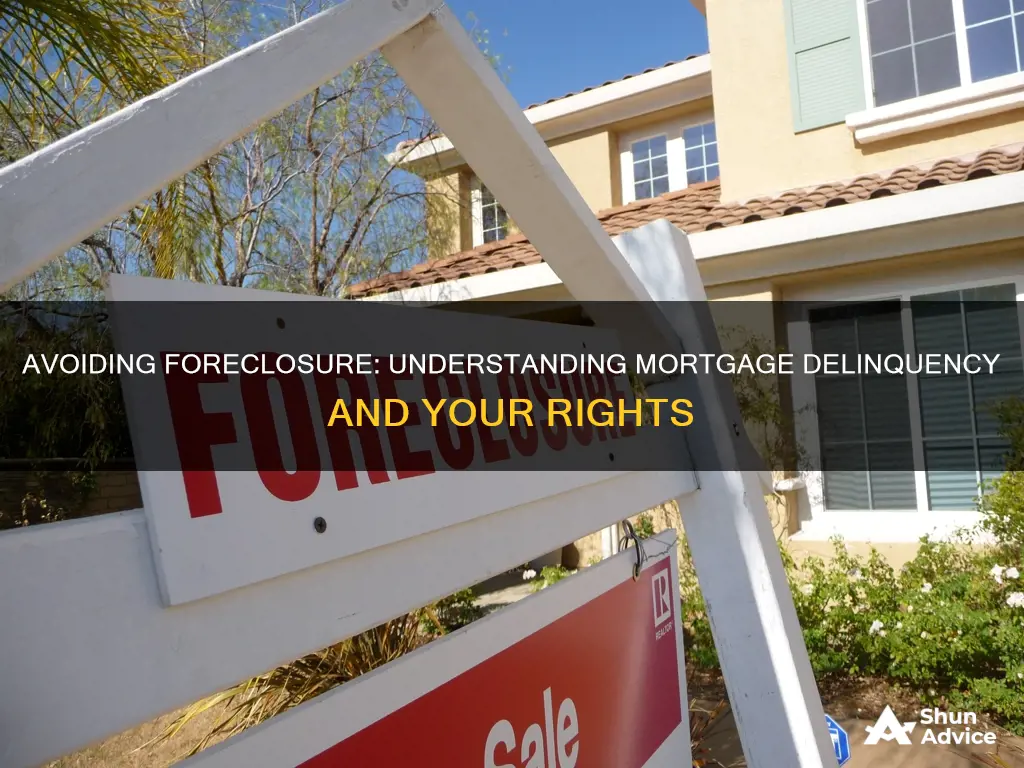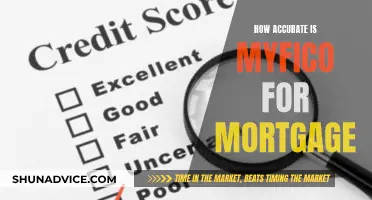
Foreclosure is a legal process that occurs when a borrower misses a certain number of mortgage payments, after which the lender takes ownership of the property and evicts the borrower to sell it. While the exact procedure varies by state, mortgage lenders typically begin foreclosure three to six months after the first missed payment. Borrowers can take several steps to prevent foreclosure, including contacting their lender, working with a housing counselor, and exploring options like repayment plans, forbearance, and deed-in-lieu of foreclosure. Understanding the specific state laws and acting quickly is crucial for borrowers facing potential foreclosure.
| Characteristics | Values |
|---|---|
| Time before foreclosure | The legal foreclosure process can't start until the borrower is at least 120 days behind on their mortgage payments. |
| Grace period | The grace period is generally between 10 and 15 days. |
| Late fee | After the grace period, the servicer can charge a late fee of 4-6% of the payment amount. |
| Foreclosure process | The foreclosure process includes payment default, notice of default, notice of trustee's sale, trustee's sale, REO, and eviction. |
| Loss mitigation | The borrower can contact their mortgage company to discuss loss mitigation options, such as forbearance plans, repayment plans, or deed-in-lieu of foreclosure. |
| Housing counselor | A HUD-approved housing counselor can help homeowners review their finances and evaluate their options to prevent foreclosure. |
| Sheriff's sale | If the default is not resolved, the lender may force a sale of the property, known as a sheriff's sale. The borrower will receive a notice of sale four weeks before the sale or a summons to court. |
| Redemption period | After the sheriff's sale, the borrower typically has a redemption period of six to twelve months, during which they can remain in the home and attempt to refinance or sell the property. |
What You'll Learn
- Foreclosure laws vary by state, but the process typically can't begin until a borrower is 120 days delinquent
- Lenders can start charging late fees after the grace period, which is usually 10-15 days
- After three missed payments, the lender can send a demand letter
- Borrowers can take action to resolve the defaulted mortgage before the sheriff's sale
- There are several ways to avoid foreclosure, including repayment plans, forbearance, and short sales

Foreclosure laws vary by state, but the process typically can't begin until a borrower is 120 days delinquent
Foreclosure laws vary by state, and the process can be carried out in different ways. However, federal law prohibits lenders from starting the foreclosure process until the borrower is at least 120 days delinquent on their mortgage payments. This law applies to both judicial and non-judicial foreclosures. In a judicial foreclosure, the lender must file a suit in court, while in a non-judicial foreclosure, the lender can initiate the process by recording or publishing the first notice.
The 120-day rule provides borrowers with some protection and time to get their finances in order or explore alternatives to foreclosure. During this period, borrowers may incur late fees, which are typically between 4% and 6% of the missed payment amount. After the grace period, which is usually about 15 days, borrowers will be charged a late fee for each missed payment.
While the 120-day rule is a standard guideline, there are some exceptions and variations. For instance, if the borrower violates a due-on-sale clause, the lender may be able to accelerate the loan balance. Additionally, if the servicer is joining the foreclosure action of a superior or subordinate lienholder, the 120-day rule may not apply.
It's important to note that once a borrower misses a certain number of payments, the foreclosure process can begin. This typically occurs after the third missed payment, when the lender sends a demand letter. At this point, borrowers have 30 days to bring their payments up to date. If they are unable to do so, the lender's attorneys may move forward with a foreclosure sale, which will be conducted in accordance with state and local laws.
Explore ARM Mortgage Refinancing Options and Customer Strategies
You may want to see also

Lenders can start charging late fees after the grace period, which is usually 10-15 days
Foreclosure is a legal process that occurs when a borrower misses a certain number of payments. The lender moves forward with taking ownership of a home to recoup the money lent. The exact foreclosure process is different depending on state law.
Mortgages often have a grace period of about 15 days. The exact length of that period is determined by the lender. If borrowers make a monthly payment during that grace period, they will not be subject to a late fee. Generally, the grace period is between 10 and 15 days. Each month you don’t pay, you’ll rack up another late charge. To learn exactly how much the late fee is in your situation, check the promissory note that you signed when you took out the loan or look at your monthly mortgage statement. Late fees typically range from 4% to 6% of the payment amount.
After the grace period expires, lenders can start charging late fees. After your first skipped payment, you will likely receive a letter or phone call from your mortgage company. If you know you are going to miss a mortgage payment, reach out to your mortgage company proactively to discuss loss mitigation options. For example, you may be able to work out a forbearance plan with your mortgage company, which would allow you to temporarily pause or reduce your mortgage payments.
After your third missed payment, your lender can send a demand letter that states how much you owe. At this point, you have 30 days to bring your mortgage payments up-to-date. As the foreclosure process moves forward, you will be contacted by your lender's attorneys and begin to incur fees. After your fourth missed payment, your lender's attorneys may move forward with a foreclosure sale. You will receive a notice of the sale in accordance with state and local laws. The amount of time between receiving the notice of the sale and the actual sale will depend on state laws. That period may be as quick as two to three months.
Mortgage Broker Regulation: What You Need to Know
You may want to see also

After three missed payments, the lender can send a demand letter
Foreclosure is a legal process that occurs when a borrower misses a certain number of payments. The exact procedure and timeline for foreclosure depend on the state, the terms of the mortgage or deed of trust, and the specific lender. However, there are some general steps and guidelines that typically apply.
To avoid foreclosure, borrowers are encouraged to take proactive measures and seek assistance as soon as they anticipate difficulty in making payments. Contacting the lender and a reputable housing counselor can help identify options for loss mitigation, such as forbearance plans, repayment plans, or short sales. Additionally, exploring alternatives like deed-in-lieu of foreclosure can help borrowers relinquish ownership of their home to the lender without going through the entire foreclosure process.
It is important to note that each situation is unique, and borrowers should not delay in seeking help. The earlier borrowers address their financial challenges, the greater the likelihood of finding a resolution that prevents foreclosure and the loss of their home.
The Intricacies of Trading Mortgage-Backed Securities
You may want to see also

Borrowers can take action to resolve the defaulted mortgage before the sheriff's sale
Foreclosure is a legal process that occurs when a borrower misses a certain number of payments. The lender moves forward with taking ownership of a home to recoup the money lent. The exact procedure is subject to different laws in each state.
In a judicial foreclosure, the foreclosing party can't start a suit in court until after the borrower is at least 120 days behind. In a non-judicial foreclosure, the servicer can't initiate a foreclosure by recording or publishing the first notice until after the 120th day of delinquency.
A sheriff's sale is part of a court-ordered process to satisfy legal judgments against the former owner of the property. A sheriff's sale auction occurs only after the lender has notified the borrower of default and has allowed for a grace period for the borrower to catch up on mortgage payments. The proceeds from properties sold at sheriff's sales go toward the mortgage lenders, tax collectors, or banks that were not paid by the previous owner.
In Minnesota, you can delay a sheriff's sale for five months by filing an Affidavit of Postponement with the county. The trade-off is that the redemption period is reduced to five weeks instead of six months. In Pennsylvania, there are three ways to possibly stop a sheriff's sale. However, it is important to act as soon as possible because there are strict deadlines.
Mortgage Market: Navigating the Perfect Storm
You may want to see also

There are several ways to avoid foreclosure, including repayment plans, forbearance, and short sales
Foreclosure is the final step before losing ownership of your home. There are several ways to avoid foreclosure, including repayment plans, forbearance, and short sales.
Repayment Plans
Repayment plans are a temporary solution for homeowners who have missed payments but expect their financial situation to improve soon. The lender agrees not to begin foreclosure proceedings while the homeowner's payments are increased to make up for the missed payments. This can be spread out over a certain period, with a percentage of the overdue amount added to each regular monthly payment. However, if the homeowner falls behind on payments again, the lender can initiate foreclosure and may be less willing to offer another repayment plan.
Forbearance
Forbearance is an agreement between the homeowner and the lender when the former is unable to make monthly mortgage payments. It allows the homeowner to temporarily reduce or pause payments. The lender agrees not to start foreclosure proceedings while the homeowner's payments are reduced or suspended. If the financial situation does not improve by the end of the forbearance period, the lender can pursue foreclosure unless another agreement is reached.
Short Sales
A short sale occurs when the value of a home is less than the mortgage balance, and the homeowner owes more than the property is worth. In this case, the bank agrees to let the homeowner sell the property for less than the balance owed on the mortgage. While the lender takes a financial loss, it may be preferable to foreclosure, which incurs additional costs for maintenance, upkeep, and transaction fees for reselling the home. It is important to ensure that the bank agrees to forgive the remaining loan balance after the sale, as any forgiven debt may be considered taxable income.
Other Options
Other options to avoid foreclosure include loan modifications, which permanently change the terms of the loan to make payments more manageable, and deeds in lieu of foreclosure, where the homeowner relinquishes ownership of the home to the lender and may be released from responsibility for the remainder of the mortgage.
Auto Loan Impact: Mortgage Application and Approval
You may want to see also
Frequently asked questions
The legal foreclosure process can't usually begin until a borrower is at least 120 days behind on their mortgage payments. However, this may vary depending on state law and the terms of your mortgage or deed of trust.
After your first missed payment, your mortgage servicer can charge a late fee of between 4% and 6% of the payment amount, but only after the grace period (usually 10-15 days) expires. You will likely receive a letter or phone call from your mortgage company.
After your third missed payment, your lender can send a demand letter stating how much you owe. You will then have 30 days to bring your mortgage payments up to date. After your fourth missed payment, your lender's attorneys may move forward with a foreclosure sale.
Foreclosure is a legal process that occurs when a borrower misses a certain number of payments. The lender moves forward with taking ownership of a home to recoup the money lent. The process typically involves payment default, notice of default, notice of trustee's sale, trustee's sale, REO, and eviction.
Contact your mortgage servicer to find out about your options. Many mortgage servicers offer loss mitigation programs to help people avoid foreclosure. You can also contact a HUD-approved housing counselling agency to get free, expert assistance on avoiding foreclosure.







